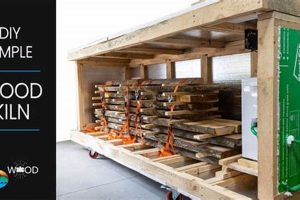The endeavor of creating fuel from compacted biomass at home involves transforming readily available organic materials, like sawdust and wood shavings, into a usable energy source. This process yields small, cylindrical objects designed for efficient combustion in specialized stoves and furnaces.
Manufacturing fuel of this nature can offer a degree of energy independence, reducing reliance on commercial suppliers and potentially lowering heating costs. Historically, the practice has gained traction during periods of economic hardship or heightened environmental awareness, reflecting a desire for self-sufficiency and sustainable resource management.
The subsequent sections will explore the necessary equipment, suitable raw materials, and step-by-step procedures for successful production, along with critical safety considerations and quality control measures.
Guidance for Home Fuel Production
The following recommendations aim to optimize the creation of fuel from compacted biomass, enhancing efficiency and safety during the process.
Tip 1: Material Selection: Prioritize dry, untreated wood waste. Contaminants like paint or preservatives can release harmful emissions and compromise fuel quality.
Tip 2: Particle Size Consistency: Ensure raw materials are uniformly ground or shredded. This promotes even compaction and consistent burn rates.
Tip 3: Moisture Content Monitoring: Maintain optimal moisture levels within the feedstock, typically below 15%. Excessive moisture hinders combustion and increases ash production.
Tip 4: Binder Usage: Consider incorporating natural binders, such as starch or vegetable oil, to improve pellet integrity and reduce crumbling during handling.
Tip 5: Equipment Maintenance: Regularly inspect and maintain pelletizing equipment. Proper lubrication and timely repairs prevent mechanical failures and ensure consistent output.
Tip 6: Gradual Introduction: When transitioning to homemade fuel, blend with commercially produced product initially. Observe the burn characteristics and adjust the mix to suit stove performance.
Tip 7: Safe Storage Practices: Store finished fuel in a dry, well-ventilated location. This prevents moisture absorption and minimizes the risk of mold growth.
Adherence to these principles can improve the quality and performance of fuel produced at home, while simultaneously mitigating potential risks associated with the process.
The subsequent conclusion will summarize the key benefits and challenges of this practice.
1. Material Preparation
Material preparation constitutes a foundational element in the effective creation of fuel at home. The characteristics of the raw materials directly influence the quality, combustion efficiency, and overall viability of the final product.
- Particle Size Reduction
Reduction of raw material particle size, typically through grinding or shredding, is critical for achieving uniform compaction. Consistent particle size promotes even density within the formed fuel, facilitating predictable burn rates. Wood shavings, sawdust, and agricultural residues often require significant size reduction before processing. Inadequate particle size control can lead to inconsistent pellet formation and increased fuel waste.
- Moisture Content Adjustment
The moisture content of the feedstock must be carefully controlled. Excess moisture hinders compaction, reduces the heating value of the finished product, and can promote mold growth during storage. Conversely, overly dry materials may not bind effectively. Optimal moisture levels typically fall within a narrow range, often necessitating drying or humidification of the raw materials prior to processing. The use of moisture meters is essential for accurate monitoring.
- Contaminant Removal
The presence of contaminants, such as metals, plastics, and treated wood, can compromise fuel quality and pose environmental risks. These materials release harmful emissions when burned and can damage combustion equipment. Thorough inspection and removal of contaminants are therefore essential. Screening and manual sorting are common methods employed to ensure the purity of the raw materials. Failing to remove contaminants can negate the environmental benefits of fuel production at home.
- Material Blending (Optional)
Blending different types of biomass can optimize the combustion characteristics of the finished fuel. For example, combining softwood with hardwood can balance burn rates and heat output. Similarly, adding small amounts of agricultural residues can enhance the binding properties of the mixture. Careful consideration of the properties of each material is essential for achieving desired results. Inappropriate blending can lead to unpredictable combustion behavior and reduced fuel efficiency.
The effective execution of these preparation steps is crucial for maximizing the efficiency and environmental sustainability of fuel production at home. Proper preparation minimizes waste, optimizes combustion, and ensures the long-term viability of this approach to energy self-sufficiency.
2. Equipment Functionality
The viability of fuel production at home is inextricably linked to the functionality of the equipment employed. A malfunctioning or improperly operated pellet mill will inevitably lead to substandard fuel, rendering the entire process inefficient and potentially hazardous. The cause-and-effect relationship is direct: consistent pellet density, crucial for predictable burn rates, is a direct result of the mill’s ability to exert uniform pressure on the raw materials. Real-world examples abound where faulty equipment has resulted in crumbled pellets, increased dust production, and incomplete combustion. This necessitates regular maintenance and a thorough understanding of the machinery’s operational parameters.
Equipment functionality extends beyond the pellet mill itself. Grinders and shredders must consistently produce feedstock of the appropriate particle size; drying systems must maintain optimal moisture levels; and conveying mechanisms must transport materials without causing blockages or contamination. The practical significance of understanding these interdependencies is substantial. A homeowner who neglects to regularly sharpen the blades of a wood chipper, for instance, will produce coarser material that is more difficult to pelletize, thereby increasing the strain on the pellet mill and shortening its lifespan. Similarly, an inadequately calibrated dryer will result in fuel that either burns poorly or crumbles during handling.
In summary, equipment functionality is not merely a peripheral concern in the creation of fuel from compacted biomass at home, but a central determinant of success. Addressing challenges related to equipment maintenance, calibration, and operational knowledge is paramount for achieving both fuel efficiency and safety. Understanding this connection is essential for anyone seeking to responsibly and effectively produce fuel for residential heating or other applications.
3. Moisture Control
Moisture control is a critical determinant of success in fuel production at home. Excess moisture within the raw materials inhibits proper compaction during the pelletizing process. This results in pellets lacking structural integrity, causing them to crumble and generate excessive dust. Furthermore, high moisture content reduces the energy density of the finished fuel, leading to decreased combustion efficiency and increased emissions. Practical examples include instances where improperly dried sawdust yields pellets that disintegrate during handling, rendering them unsuitable for use in automated feeding systems. The significance of accurate moisture measurement cannot be overstated; a moisture meter is an essential tool.
Conversely, materials that are excessively dry can also present challenges. While dry materials facilitate compaction, they may lack the inherent binding properties necessary to maintain pellet integrity. This can lead to similar issues of crumbling and dust generation. In such cases, the addition of a binding agent, such as vegetable oil or starch, is often necessary to compensate for the lack of natural adhesion. Achieving an optimal moisture balance requires careful monitoring and adjustment of the raw materials, often involving a combination of drying and humidification techniques, depending on the initial moisture content of the feedstock.
In conclusion, effective moisture control is paramount for maximizing the quality and usability of fuel produced at home. Inadequate moisture management negatively impacts fuel density, combustion efficiency, and handling characteristics. Achieving an optimal moisture balance through meticulous monitoring and adjustment is essential for ensuring the economic and environmental viability of this process.
4. Compaction Pressure
Compaction pressure is a governing factor in the production of fuel from compacted biomass. It directly influences the density, durability, and combustion characteristics of the resulting material. Insufficient pressure results in fragile pellets susceptible to crumbling, rendering them unsuitable for automated feeding systems and increasing dust production. Conversely, excessive pressure can damage equipment and increase energy consumption without necessarily improving pellet quality. Real-world examples demonstrate that suboptimal compaction pressure leads to incomplete combustion, reduced heating efficiency, and increased particulate emissions.
The relationship between compaction pressure and fuel quality is not linear; it is influenced by the material composition and moisture content. Different types of wood, agricultural residues, and binding agents require specific pressure settings to achieve optimal pellet formation. For example, softwood often requires lower pressure compared to hardwood due to its inherent binding properties. Moreover, accurate calibration of the pellet mill and regular maintenance of its components are essential to maintain consistent compaction pressure over time. Practical application involves monitoring pellet density and adjusting pressure accordingly to achieve the desired fuel characteristics.
In summary, appropriate compaction pressure is a critical parameter in fuel production at home. Insufficient or excessive pressure negatively affects fuel quality and combustion efficiency. Careful consideration of material characteristics, equipment calibration, and ongoing monitoring are essential for optimizing compaction pressure and achieving reliable and sustainable fuel production. Understanding this interplay is paramount for those seeking to create effective and environmentally sound fuel from biomass.
5. Binder selection
Binder selection is a pivotal consideration in the context of fuel production at home, significantly influencing the structural integrity, handling characteristics, and combustion behavior of the finished product. The absence of an appropriate binder, particularly when utilizing materials with limited natural adhesion, often results in pellets that crumble easily, generate excessive dust, and are difficult to handle, thereby negating many of the advantages of using compacted biomass as a fuel source. Real-world examples illustrate that without a suitable binding agent, pellets composed primarily of dry sawdust, for instance, will frequently disintegrate during storage and transport, rendering them unsuitable for automated feeding systems. The importance of this selection stems from its direct impact on the practicality and economic viability of the endeavor.
The selection of a binder necessitates a careful evaluation of several factors, including the inherent binding properties of the base materials, the desired combustion characteristics of the fuel, and the environmental impact of the binder itself. Common binder options include natural substances such as starch, vegetable oil, and lignin, each offering distinct advantages and disadvantages. Starch, for example, is readily available and relatively inexpensive, but may increase ash production during combustion. Vegetable oil improves pellet durability and enhances energy content but can be more costly. Lignin, a natural polymer found in wood, offers excellent binding properties and minimal environmental impact but may require specific extraction processes. The practical application of this knowledge involves conducting small-scale trials with different binders to determine the optimal type and concentration for a given feedstock.
In conclusion, the strategic selection of a binder is an indispensable component of successful fuel production at home. Neglecting this aspect can lead to substandard fuel quality and operational inefficiencies. Careful consideration of material properties, combustion requirements, and environmental impact is essential for maximizing the benefits of this practice and ensuring its long-term sustainability. Further research into novel and environmentally friendly binding agents holds significant promise for enhancing the viability of fuel production as a source of renewable energy.
6. Safety Precautions
The intersection of safety precautions and fuel production at home is critical, as the process inherently involves potential hazards. The operation of machinery like grinders and pellet mills introduces risks of physical injury, necessitating the consistent use of personal protective equipment, including safety glasses, hearing protection, and work gloves. Inadequate adherence to these measures can result in severe consequences, ranging from lacerations and fractures to permanent hearing loss. The cause-and-effect relationship is direct: neglecting safety protocols increases the probability of accidents and injuries. The practical significance of understanding this connection lies in minimizing potential harm and ensuring a safe working environment.
Furthermore, the handling and storage of raw materials and finished fuel present additional safety concerns. Dust generated during grinding and pelletizing can be highly flammable, posing a risk of explosions. Implementing proper ventilation and dust collection systems is essential for mitigating this hazard. Improper storage of fuel can lead to spontaneous combustion, particularly if the material is not adequately dried. Adhering to recommended storage guidelines, including maintaining appropriate ventilation and monitoring temperature, is crucial for preventing fires. As an example, reports of fires originating in improperly stored fuel underscores the tangible risks associated with neglecting safety measures.
In conclusion, a comprehensive understanding and strict adherence to safety precautions are paramount in fuel production at home. The failure to prioritize safety can result in physical injuries, equipment damage, and environmental hazards. Consistent use of personal protective equipment, implementation of dust control measures, and adherence to proper storage guidelines are essential for ensuring a safe and sustainable operation. Integrating these safety measures is not merely an option but a fundamental requirement for responsible fuel production.
7. Storage Conditions
Storage conditions are a critical determinant of the long-term viability and effectiveness of fuel created at home. Improper storage can negate the efforts invested in careful material selection, preparation, and pelletization. The primary concern revolves around moisture absorption, which diminishes the fuel’s heating value, promotes fungal growth, and accelerates disintegration. A direct cause-and-effect relationship exists: inadequately protected fuel readily absorbs atmospheric moisture, leading to reduced combustion efficiency and increased particulate emissions when burned. For example, fuel stored in damp basements or uncovered outdoor areas will experience significant degradation within a matter of weeks. The practical significance of this understanding lies in preventing wasted resources and ensuring reliable fuel performance.
Optimizing storage conditions involves selecting a dry, well-ventilated location and employing moisture-resistant containers or coverings. Elevated storage platforms prevent ground moisture from seeping into the fuel, while breathable covers allow for air circulation, minimizing the risk of condensation. Periodic inspections are essential to detect any signs of moisture intrusion or pest infestation. Furthermore, large-scale storage necessitates careful stacking to prevent compression and airflow obstruction. In practical terms, airtight containers stored in climate-controlled environments represent the ideal scenario, although more economical solutions, such as covered sheds or tightly sealed bags, can provide adequate protection under most circumstances.
In conclusion, maintaining proper storage conditions is indispensable for preserving the quality and usability of fuel produced at home. Neglecting this crucial aspect can compromise fuel performance, increase environmental impact, and undermine the economic benefits of fuel production. Adherence to recommended storage practices ensures long-term fuel stability, consistent combustion efficiency, and a more sustainable energy solution.
Frequently Asked Questions About Fuel Production at Home
This section addresses common inquiries and misconceptions surrounding the creation of fuel from compacted biomass, offering guidance based on practical experience and established best practices.
Question 1: Is it economically viable to produce fuel at home compared to purchasing commercially available product?
Economic viability hinges on several factors, including the cost of raw materials, equipment investment, labor input, and the volume of fuel consumed. A comprehensive cost-benefit analysis is essential to determine if the practice is financially advantageous in a specific context. Often, the economic benefits are greatest when access to low-cost or free raw materials is readily available.
Question 2: What are the primary environmental considerations associated with fuel production at home?
Environmental considerations encompass factors such as feedstock sourcing, emissions during combustion, and the disposal of ash. Sustainable sourcing of raw materials is crucial to avoid deforestation or habitat destruction. Efficient combustion practices minimize particulate emissions and greenhouse gas production. Proper ash disposal prevents soil contamination. A holistic approach to environmental stewardship is essential.
Question 3: What types of raw materials are suitable for fuel production at home?
Suitable raw materials generally consist of dry, untreated wood waste, agricultural residues, and other forms of biomass. Particle size and moisture content are critical parameters. Contaminants such as plastics, metals, and treated wood should be strictly avoided. Material selection should prioritize sustainability and minimize environmental impact.
Question 4: What equipment is required for fuel production at home, and what are the associated costs?
Essential equipment includes a grinder or shredder, a pellet mill, and a drying system (if necessary). Costs vary significantly depending on the size and capacity of the equipment. Used equipment can offer a more affordable alternative, but careful inspection for wear and tear is essential. Budgeting for maintenance and repairs is also crucial.
Question 5: What are the potential safety hazards associated with fuel production at home, and how can they be mitigated?
Potential safety hazards include physical injuries from machinery, fire risks from dust accumulation and improper storage, and exposure to harmful emissions during combustion. Mitigation strategies involve the use of personal protective equipment, proper ventilation, dust collection systems, and adherence to recommended storage practices. Prioritizing safety is paramount.
Question 6: How can the quality of fuel produced at home be assessed and maintained?
Fuel quality can be assessed by evaluating its density, moisture content, and ash content. Consistent pellet size and shape are also indicators of quality. Regular equipment maintenance and proper material preparation are essential for maintaining consistent fuel quality. Testing a small batch before large-scale production is recommended.
In summary, while fuel production at home can offer certain advantages, a thorough understanding of the economic, environmental, and safety considerations is crucial for informed decision-making and responsible implementation.
The subsequent conclusion will summarize the key benefits and challenges of this practice.
Conclusion
The preceding exploration of “diy wood pellets” has illuminated both the potential benefits and inherent challenges associated with this practice. From material selection and preparation to equipment functionality and safety protocols, the process demands a comprehensive understanding and meticulous execution. Achieving consistent fuel quality and mitigating environmental risks necessitate a commitment to best practices and ongoing monitoring.
Ultimately, the decision to engage in “diy wood pellets” requires a thorough assessment of individual circumstances, resources, and priorities. While the prospect of energy independence and cost savings may be appealing, the commitment to responsible production and adherence to stringent safety standards must remain paramount. Further research and development in biomass conversion technologies may offer future advancements, but the present reality demands a cautious and informed approach.







